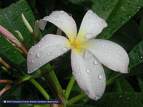Plant of the Week
July 30, 2006
By Manuel Santos,
Master Gardener-Class 1
 One can easily say Plumerias can produce the most beautiful flowers in the world. They are certainly lovely to see blooming in the early spring and summer in this warm climate. While they are a tropical species, it is interesting to know that wild Plumerias were found in hot areas often in poor soil and rocky limestone cliffs–typical to what we experience in our garden environments here in San Antonio.
One can easily say Plumerias can produce the most beautiful flowers in the world. They are certainly lovely to see blooming in the early spring and summer in this warm climate. While they are a tropical species, it is interesting to know that wild Plumerias were found in hot areas often in poor soil and rocky limestone cliffs–typical to what we experience in our garden environments here in San Antonio.
 While they respond readily to water and fertilizationan over abundance of either can produce problems and create leggy growth and fewer flowering clusters. In a container culture, over watering can result in a loss of root due to lack of air in the soil medium. It is best that containers dry completely between watering periods. It has been noted that Plumerias in their native habitat, shed their leaves during long hot spells, then releafing when there is sufficient water available. For good flowering, light and temperature are probably more important than water. Plumeria trees flourish in full sunlight; they set very few buds when shaded by taller trees or buildings. Very little growth or flowering occurs once the temperatures drop below sixty. When this occurs it is best to bring the plant indoors and allow them to go dormant in a garage or a shelter where they won’t freeze. In March or April you can repot them if needed, and set them out in a sunny location.
While they respond readily to water and fertilizationan over abundance of either can produce problems and create leggy growth and fewer flowering clusters. In a container culture, over watering can result in a loss of root due to lack of air in the soil medium. It is best that containers dry completely between watering periods. It has been noted that Plumerias in their native habitat, shed their leaves during long hot spells, then releafing when there is sufficient water available. For good flowering, light and temperature are probably more important than water. Plumeria trees flourish in full sunlight; they set very few buds when shaded by taller trees or buildings. Very little growth or flowering occurs once the temperatures drop below sixty. When this occurs it is best to bring the plant indoors and allow them to go dormant in a garage or a shelter where they won’t freeze. In March or April you can repot them if needed, and set them out in a sunny location.
Once the danger of frost is over they will set new buds and will become alive with new growth and blooms and will be happy throughout the spring and summer. The cuttings will propagate easily placed in a container with a moderate water regimen. Plumeria flowers have a jasmine like fragrance pleasing to the garden. While it is known that Plumerias can grow in poor soil conditions, it is best to have them in good soil with proper drainage. Also it is important that the plants have enough water during the summer months. They will require six to eight hours of full sunlight to be happy. Most common insect on these plants are aphids and white flies; these can be controlled with a strong spray of water and dish soap.
THE HISTORY
 The Plumeria was named in honor of Charles Plumier (1648-1704). He was a noted Botanist and Franciscan Monk who traveled extensively to South America and other parts of the world in the search for plant species for medicinal use. He studied the cinchona bark which contained a chemical later to be known as Quinine for dealing with Malaria. On one of his trips to the jungles of Santo Domingo he discovered many hundreds of plant species, of which 100 new genera were discovered. He was also credited in 1694 to have proved the Cochineal (Red Scale) as a member of the animal kingdom and classified an insect. This insect later became very important to the textile industry and was use to create an intense red dye.
The Plumeria was named in honor of Charles Plumier (1648-1704). He was a noted Botanist and Franciscan Monk who traveled extensively to South America and other parts of the world in the search for plant species for medicinal use. He studied the cinchona bark which contained a chemical later to be known as Quinine for dealing with Malaria. On one of his trips to the jungles of Santo Domingo he discovered many hundreds of plant species, of which 100 new genera were discovered. He was also credited in 1694 to have proved the Cochineal (Red Scale) as a member of the animal kingdom and classified an insect. This insect later became very important to the textile industry and was use to create an intense red dye.
Charles Plumier used the names of other famous doctors and botanists to name some of his discoveries. For example, “Fuchisia tripulla flore coccinea” was named in honor of German Botanist and Physician, Leonhart Fuchs (1501-1616). Begonia was named in honor of the commander of the Port of Marseille called “Begon.” Lobelia was named in honor of another French Botanist Mathais Lobel. Charles Plumier never named a plant after himself. The genus name, Plumeria, was given to this plant by French Botanist Joseph de Tournefort, and Swedish Botanist Linnaeus, “The Father of Botany,” to honor Charles Plumiers contribution in the area of Botany. There is much more interesting information and history at http://www.plumeria101.com/